PinotFile: 11.44 June 2, 2019
|
On the Pinot Trail in Sonoma County
Such a lovely place Any time of the year you can find me here I can check out any time I like But I can never leave! Rescripted from ‘Hotel California,’ The Eagles
I just spent three marvelous weeks in Sonoma County wine country, a region that lives up to its marketing byline that Sonoma County is where “Life Opens Up.” I want to reprise my trip including winery visits.
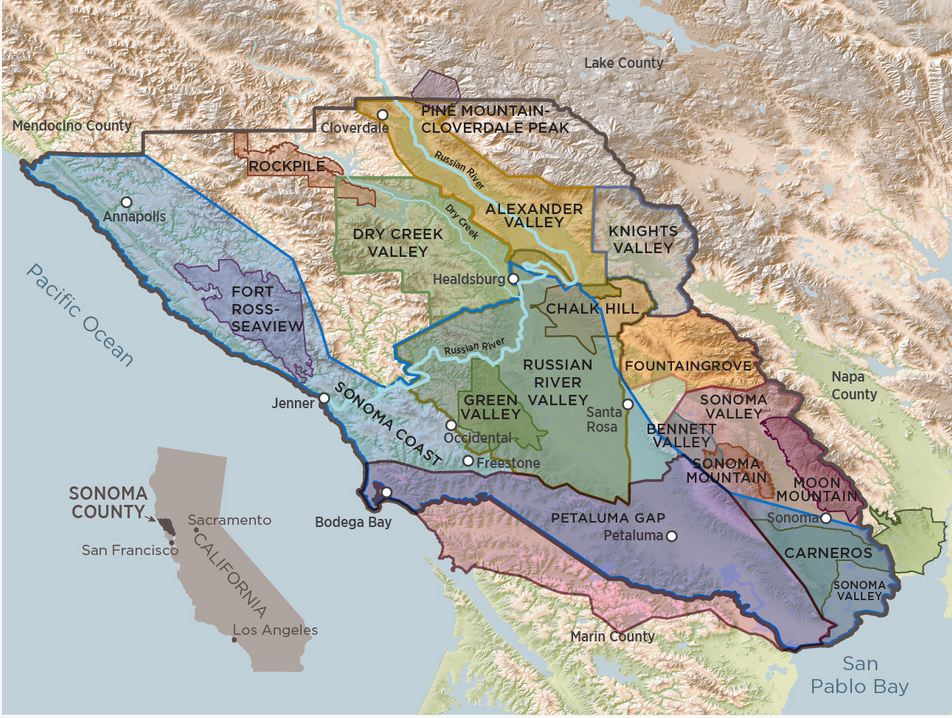 Sonoma County is home to 61,000 acres of vineyards, 1,300 grape growers (80 percent farm less than 100 acres) and more than 425 wineries, stretching 1,500 square miles from the Pacific Coast in the West to the Mayacamas Mountains to the East and Mendocino County in the North to Marin County in the South. It is the most accessible wine region in California, about a 45-minute drive from San Francisco and easily reached by air service to The Charles M. Schulz County Airport (STS) in Santa Rosa from Los Angles, Orange County, Portland, Seattle, San Diego, Phoenix, Dallas/Fort Worth, Denver and seasonally, Minneapolis/St. Paul and Las Vegas. It is less than a two-hour drive from three international airports in San Francisco, Oakland and Sacramento. There are 18 appellations in Sonoma County and more than 60 varietals are grown there, but Pinot Noir and Chardonnay make up the vast majority of production. When it comes to Pinot Noir and Chardonnay, my focus, the appellations of interest include Bennett Valley (700 vineyard acres and 17 wineries), Carneros (6,481 vineyard acres and 22 wineries), Fort Ross-Seaview (515 vineyard acres and 5 wineries), Green Valley (2,860 vineyard acres and 10 wineries), Russian River Valley (13,896 vineyard acres and 94 wineries), Sonoma Coast (5,055 vineyard acres and 7 wineries) and Sonoma Mountain (667 vineyard acres and 3 wineries. An additional AVA, the West Sonoma Coast AVA, is nearing approval. This region, known as the “true” Sonoma Coast, is 51-miles long and is home to some of California’s best Pinot Noir vineyards. Winegrowers members of the West Sonoma County Vintners have been trying for several years to obtain approval for a West Sonoma Coast AVA to distinguish it from the very large Sonoma Coast AVA. The new West Sonoma Coast AVA would encompass the Fort Ross-Seaview AVA and Green Valley AVA as well as the Annapolis, Freestone, Occidental and Sebastopol Hills regions. Many of the most desirable appellations for Pinot Noir and Chardonnay are foggy with significant maritime influence and well-draining Goldridge soils. That said, there is an immense amount of microclimate and soil variety, making Sonoma County flush with terroir riches. It is noteworthy that the Russian River Valley alone has more soil diversity than Burgundy, with a multitude of types in the Alluvial, Franciscan Complex, Volcanic and Wilson Grove series.
Any trip to Sonoma County that focuses on Pinot Noir and Chardonnay is best served by a base in the Russian River Valley. This appellation, approved in 1983 and enlarged in 2005, is 15 miles wide and tall and contains 1/6 of the total vineyard acreage of Sonoma County. Some of the oldest grapevines in California are planted here, including the oldest Pinot Noir vines. Russian River Valley is the epicenter of Pinot Noir in Sonoma County and all other neighboring pinot-centric Sonoma County appellations can easily be reached by a short drive. The Russian River Valley has three main cities that span the appellation from north to south - Healdsburg, Santa Rosa and Sebastopol - and I found myself staying in all three cities during my recent trip. It is only a three letter word, but fog is the defining characteristic of the Russian River Valley appellation. The regular ebb and flow of fog originates from the Pacific Ocean a few miles to the West and enters the Valley primarily through the Petaluma Wind Gap and secondarily along the channel created by the Russian River that empties into the Pacific Ocean at Jenner. The fog arrives in the late afternoon and evening, frequently dropping the temperature 30 degrees from its daytime high and then retreats the following morning. This maritime air conditioner extends the growing season and allows grapes to reach full flavor maturity while retaining natural acidity. A four letter word, rain, has been on everyone’s mind in Sonoma County. Rain totals in Santa Rosa by May 16 were 46”, 131% of normal. The concern with the latest May rains is that vine bloom was beginning in some vineyards and the rain may markedly interfere with resulting yields. There will probably be no impact on quality, just on yield.
In the pages to follow I will report on tastings done at several wineries I visited on my recent trip. I will add suggestions on lodging, restaurants and activities that can assist the reader in planning a trip to Sonoma County in the next issue. Please feel free to contact me at any time to help plan Sonoma County trips including arranging exclusive private tastings. One final comment about Sonoma County. It is laughable that Sonoma County and Napa County have a contentious relationship much like Bordeaux and Burgundy in France. Napa has the richer, more refined elite populace with many grand estates, expensive Cabernet Sauvignon wines, tony resorts and a bit of arrogance, while “Sonomians” are more Bohemian (the local paper is The Bohemian), relish craft beer, enjoy and tout the commoner Zinfandel wine, and ply country roads with many bumps and potholes. Contrast Grateful Dead drummer Mickey Hart who is a longtime Sebastopol resident with pop music artist John Legend who collaborates with Raymond Vineyards in Napa to produce a Cabernet Sauvignon. I was surprised to learn that people that grow up in Napa County never or rarely go to Sonoma County, and vice versa, despite the short drive separating the two distinguished but disparate neighbors.
Dry Creek Valley: Ten Acre Winery & Reeve Wines
Although warm days are tempered by morning fog from the Pacific, it is still too warm an area for Pinot Noir. Still, there are a few notable producers of sourced Pinot Noir in the Dry Creek AVA including Ferrari-Carano, Jigar Wines, Kokomo, Papapietro Perry, Williamson Wines, and the two wineries I recently visited, Ten Acre and Reeve.
Ten Acre WineryWinemaker Michael Zardo is quietly crafting superb Chardonnay and Pinot Noir at Ten Acre Winery. With 18 vintages under his belt, including several vintages as assistant winemaker at Pisoni Vineyards, he knows what he is doing. Grapes are sourced from the Russian River Valley, Sonoma Coast and Santa Lucia Highlands Vineyards. Ten Acre Winery was founded by Scott and Lynn Adams, who became winegrowers more than fifteen years ago when they acquired their first estate 10-acre vineyard located two miles from Rochioli Vineyard in 1995. In 1999 they established Bella Vineyards and Wine Caves in Dry Creek Valley, specializing in Zinfandel and Rhone wines. With their growing passion for Burgundian varietals, they founded Ten Acre Winery based at Bella to focus on small lots of Pinot Noir and Chardonnay. I visited Michael recently at Bella Vineyards and Wine Caves and tasted through the 2017 offerings. These wines will be released in the fall of 2019. My 2018 review of the 2016 vintage wines can be read at www,princeofpinot.com/article/2087/.
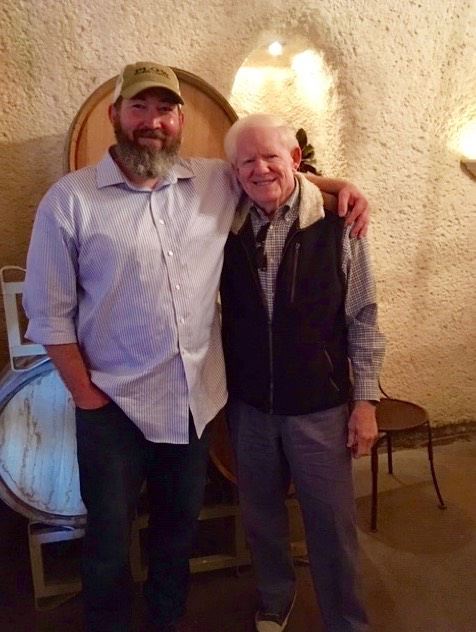 I was stunned by the 2015 Ten Acre Ritchie Vineyard Chardonnay and the 2016 and 2017 versions are equally exceptional. This wine just might be my favorite California Chardonnay. Private tastings are available by appointment at the Hotel Duchamp in Healdsburg or on the terrace at Bella Vineyards with breathtaking views of the Dry Creek Valley. Visit www.tenacrewinery.com. If you are fortunate to taste with Michael, be sure and ask him about his other passion - smoking meats, poultry and fish. All wines reviewed here were vinified with native fermentation. The Chardonnays undergo 100% malolactic fermentation and are aged in 40% new French oak. The Pinot Noirs strike the middle ground between forward drinking and age-worthiness.
2017 Ten Acre Russian River Valley Pinot Noir 14.3% alc., 250 cases, $48. · Moderately light garnet color in the glass. Highly aromatic, featuring scents of red cherry, rose petal and sandalwood. Light to mid weight in style, offering elegantly composed flavors of red cherry and berry framed by modest tannins. An outstanding up-front sipper. Score: 89
2017 Ten Acre Sonoma Coast Pinot Noir 14.1% alc., 203 cases, $55. A blend of fruit from Three Perch and Jenkins vineyards. · Moderate garnet color in the glass. Very appealing aromas of darker red and purple fruits with hints of spice and white pepper. More concentrated than the Russian River Valley bottling, featuring a mid weight array of blue and purple fruits along with a touch of oak and licorice. Nicely integrated tannins and some finishing persistence. Score: 90
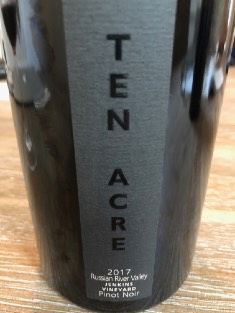 2017 Ten Acre Jenkins Vineyard Russian River Valley Pinot Noir 14.1% alc., 228 cases, $68. 7-10% whole cluster. · Shy aromas of smoky black cherry lead to a middleweight wine offering tasty flavors of blue and purple berries. Nicely composed, with chewy tannins and a big finish.When tasted the following day from a previously opened and re-corked bottle, the wine had opened up and the suave, melt-in-the-mouth texture was appealing as was the sweet blackberry finish. Excellent balance. Score: 93-94
2017 Ten Acre Earl Stephens Vineyard Russian River Valley Pinot Noir 14.2% alc., 200 cases, $65. This 10-acre vineyard is a warmer site located on a steep hill near Iron Horse Vineyards. Pommard, 115, 777 and 667 clones. 5-10% whole cluster. · Moderate garnet color in the glass. Aromas of dark cherry and berry, spice and friendly oak. Seductive flavors of black fruits in a mid weight plus style. When tasted the following day from a previously opened and re-corked bottle, the oak overlay had receded, and the stellar black raspberry finish was exquisite. Score: 93-94
2017 Ten Acre Soberanes Vineyard Santa Lucia Highlands Pinot Noir 14.6% alc., 157 cases, $75. · Moderately dark garnet color in the glass. The fruit-driven nose offers aromas of black cherry and black raspberry liquor. Deeply flavored, with waves of black grape, blackberry and black currant fruits flooding the palate. Modest tannins with admirable balance and a generous fruit-filled finish. Score: 92-93
2017 Ten Acre Three Perch Vineyard Sonoma Coast Pinot Noir 14.5% alc., 180 cases, $75. An anomalous year for this wine in that it is very dark and concentrated. · Dark garnet color in the glass. Rich dark fruits perfuse the nose. Full-bodied in a Zinfandel style featuring an array of ripe dark fruits framed by healthy tannins and finishing with a flood of fruit. This is a wine for fruit hedonists only and quite atypical for Pinot Noir. Score: 90-91
2017 Ten Acre Soberanes Vineyard Santa Lucia Highlands Chardonnay 14.4% alc., 150 cases, $65. A variety of Chardonnay clones in the vineyard and in the wine. · Fruity aromas of pear, apple and citrus. Aciddriven, with flavors of green and yellow apple and lemon, finishing tight and quenching. Score: 92
2017 Ten Acre Ritchie Vineyard Russian River Valley Chardonnay 14.4% alc., 168 cases, $68. A combination of E Block (cane pruned with more acidity) and A Block (cordon pruned with some tropical notes from musque-type Wente selections). · Wonderful aromas of lemon, spice, caramel, toasty brioche and botanical notes. Luscious and intensely flavored, offering delicious tastes of lemon meringue, pineapple, peach, melon, and a hint of caramel. A connoisseur’s Chardonnay that finishes long and intense. Score: 95
2017 Ten Acre Ritchie Vineyard Horseshoe Block Russian River Valley Chardonnay 14.2% alc., 168 cases, $78. · The nose is similar to the regular Ritchie bottling but not as much fruit ripeness. The aromatics really soar over time in the glass. Brighter than the regular Ritchie bottling with more cut on the long, dry finish. A delightful wine centered around white stone fruit flavors that has energy to spare. Score: 96
Reeve WinesMy oldest son turned 40 in April and celebrated with 25 friends in Sonoma County wine country. My wife and I were part of the celebration as well. One highlight of the weekend revelry was a visit to Reeve Wines. When in Healdsburg, one is often occupied with the many tasting rooms downtown or the legendary producers of Pinot Noir on nearby Westside Road, the “Rodeo Drive” of Pinot Noir. For a different adventure, I suggest heading north on East Dry Creek Road to The Reeve Estate and Tasting Room in Dry Creek Valley, an area known for warm-weather varietals such as Zinfandel more than Pinot Noir. You won’t be disappointed if you love Pinot Noir, as several inviting examples are offered produced with grapes sourced from areas like Anderson Valley, the Sonoma Coast and the Santa Cruz Mountains. Only a 10-minute drive from downtown Healdsburg, Reeve Estate is a world apart. Enter through a long treelined driveway to an oasis where you can taste wine in a secluded nirvana with both inside and outdoor seating and “dope” music playing. Young wine enthusiasts of Gen X and Millenial age group will particularly enjoy the experience.
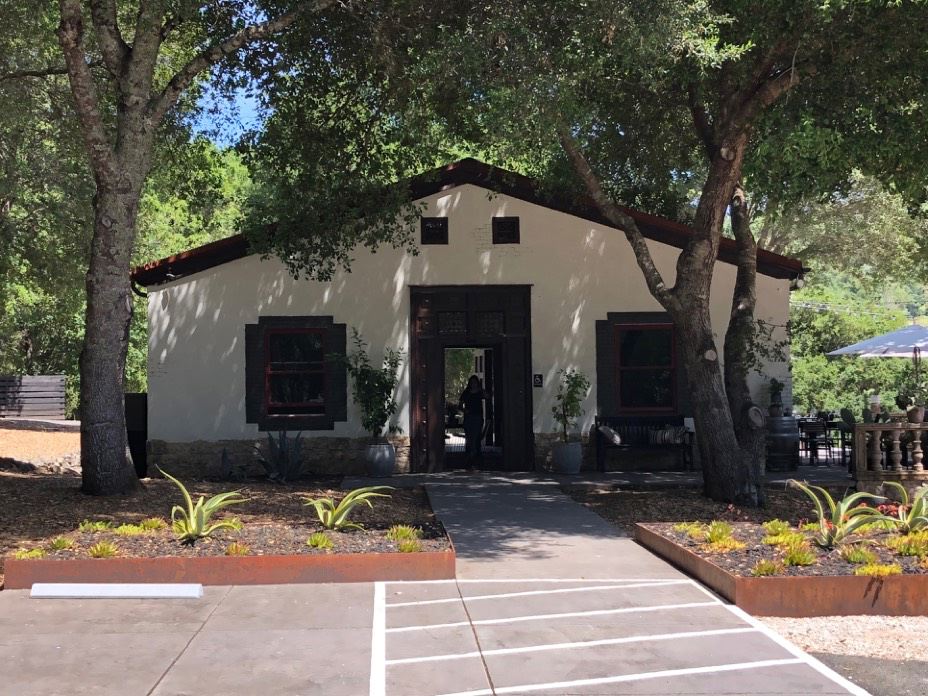 Reeve Wines is a collaborative effort between Noah and Kelly Dorrance, and well-known consulting winemakers Ross Cobb (COBB Wines) and Katy Wilson (LaRue, Anaba). Over the years the Dorrances built the wildly popular Banshee Wines label which they sold. Reeve, launched in 2015, allows them to explore other varietals such as Cabernet Sauvignon, Sangiovese and Riesling in addition to Pinot Noir. I would describe the small production wines as “friendly,” meaning they are easy to drink upon opening, yet have the balance to age in the bottle. They represent excellent value (Pinot Noirs are about $38-$65). The two wines reviewed here may be sold out through the winery’s Wine Club and Mailing List by the time you read this. Tasting is available daily by appointment ($35 per person with additional fees for groups over eight people). Well-behaved dogs and children are welcome. The staff are extremely friendly, laid-back and knowledgeable and make you feel very welcome. A beautiful villa on the property and farm stay is available for rental. Visit the website at www.reevewines.com and Instagram feed at poshnet.net/tag/reevewines.
2017 Reeve Ascona Vineyard Santa Cruz Mountains Pinot Noir 13.6% alc., 175 cases, $N/A. · Moderately light ruby red color in the glass. Aromas of red cherry, red cranberry, herbs and dusty path lead to delicate and elegant styled wine featuring a core of red cherry fruit that delivers more flavor intensity than one would expect. Very easy going, with silky tannins, a hint of sweetness, and some length on the finish. The gossamer side of Pinot that speaks of summer. Score: 90
2017 Reeve Rhoda Anderson Valley Pinot Noir 13.3% alc., pH 3.39, TA 0.64, $48. A blend of fruit from Tanbark Mill, Kiser and Wendling vineyards · Moderate garnet color in the glass. Nicely perfumed with aromas of cherry, spice, and fertile earth. A charge of juicy cherry and boysenberry fruits along with a subtle savory note of herbs caress the palate with goodness and freshness. Impeccable harmony. More structured than the Ascona Vineyard bottling and a better match for hardier foods. Score: 93
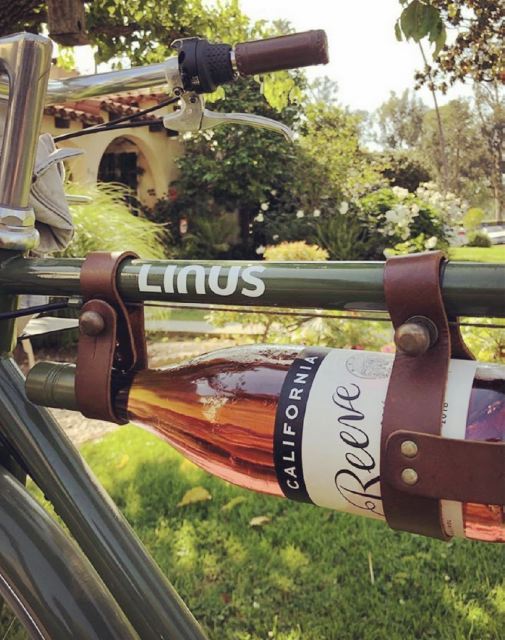
Sonoma: Sojourn Cellars, Talisman & En Garde
Sojourn CellarsSojourn Cellars has a long-established but recently renovated and very comfortable tasting salon in the Plaza area which I visited for the first time. I tasted the fall 2019 releases with Co-founder and Winemaker Erich Bradley and General Manager and Associate Winemaker Randy Bennett (on the right in the photo below). I have been tasting the consistently excellent wines for years (since 2004) but finally having visited the crew including Co-founder Craig Haserot at the salon, and gazed on the mural depicting the vines at Gap’s Crown Vineyard, I felt fully engaged and impressed by the magic the wines and dedicated tasting staff offer. This is a professionally-run winery. For example, the tech sheets given to me to accompany each wine are complete in every detail and a blessing to wine writers who relish the complete story of each wine.
 The full story of Sojourn Cellars can be read here: www.princeofpinot.com/article/328/. The tasting salon is open daily by appointment. Visit www.sojourncellars.com for further information and to view the latest short videos about the winemaking and vineyard sources. The following wines were tasted in May at the Sojourn Cellars tasting salon and at home in my usual fashion. The map below depicts the location of vineyard sources.
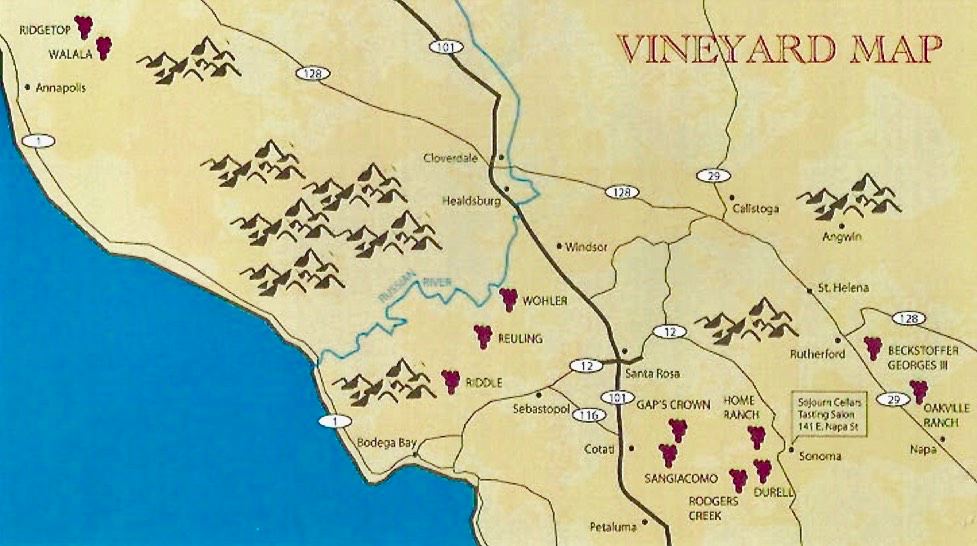 Fortunately, all the Sojourn Chardonnay and Pinot Noir grapes were picked prior to the tragic wildfires on October 8-9, 2017, and there was no impact on the wines.
2017 Sojourn Russian River Valley Pinot Noir 14.2% alc., pH 3.66, TA 0.61, 625 cases, $45. Release fall 2019. A blend of vineyards including Wohler, Riddle, Pratt and Reuling. 100% de-stemmed, 4-day cold soak, native yeasts initiated fermentation that lasted 10-14 days. Aged 11 months in French oak barrels, 50% new. Bottled unfined and unfiltered in August 2018. · Moderate garnet color in the glass. Leading off are aromas of black cherry, spice, rose petal and tobacco ash. Juicy and silky on the palate in a mid weight style featuring a core of oak-kissed dark cherry. Forward drinking, with silky tannins and a modest cherry-fueled finish. The burnt tobacco thread reflects heavy-handed oak. Score: 88
2017 Sojourn Wohler Vineyard Russian River Valley Pinot Noir 14.2% alc., pH 3.72, TA 0.60, 575 cases, $54. Release fall 2019. Clones 667, “828,” 115, 777 and 2A. This vineyard, developed by Mark Aubert, has found more balance in recent years. Vineyard was harvested in multiple passes to best time ripening. 100% de-stemmed, native yeast fermentation in open-top fermenters, aged 11 months in French oak barrels, 50% new. Bottled unfined and unfiltered in August 2018. · Moderately light garnet color in the glass. Highly aromatic with scents of dark cherry, cola and baking spices. Middleweight in style, with a flamboyant cherry core. Polished in the mouth, with an intervention of toasty oak in the background and minimal tannins. Score: 90
2017 Sojourn Reuling Vineyard Sonoma Coast Pinot Noir 14.4% alc., pH 3.68, TA 0.58, 425 cases, $69. Release fall 2019. Calera and two suitcase clones from Vosne-Romanee fermented separately and then blended just prior to bottling in August 2018. 100% de-stemmed, native yeast fermentation, aged 11 months in French oak barrels, 50% new. Bottled unfined and unfiltered. · Moderate garnet color in the glass. This wine offers an impressive balance between fruit and savory characters and is the most savory wine in the 2017 lineup. Aromas of dark red and blue berries, spice, and mushrooms on the grill. Mid weight in style, and offering earthy, even animale notes infusing the chewy cherry and blueberry fruit flavors. Nicely integrated oak, with a silky mouthfeel, balanced tannins and a pleasing finish. Score: 93
2017 Sojourn Riddle Vineyard Sonoma Coast Pinot Noir 14.4% alc., pH 3.69, TA 0.60, 400 cases, $59. Release fall 2019. A high-density planted vineyard in Goldridge soil that dates to 2008. Clones 115, “828,” Pommard and Mt. Eden (the “secret sauce” in this wine) fermented separately. 100% de-stemmed, native yeast, aged 11 months in French oak barrels, 50% new. Bottled unfined and unfiltered in August 2018. · Moderate garnet color in the glass. Engaging aromas of red cherry and berry, baking spices and a savory note. Darker fruited on the palate, with glamorous flavors of black cherry, blueberry, boysenberry and spice that attack the palate with intent. Vigorous, but not intrusive tannins provide textural interest. The long finish will make your heart throb. When tasted the following day from a previously opened and re-corked bottle, the wine was even more expressive on the nose and palate and continued to exhibit the best finish in the lineup of wines tasted. Score: 94
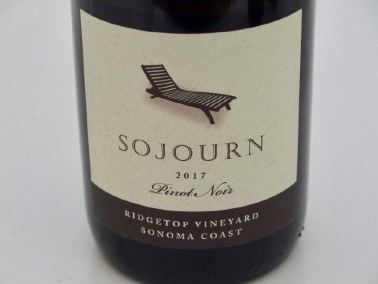 2017 Sojourn Ridgetop Vineyard Sonoma Coast Pinot Noir 14.4% alc., pH 3.69, TA 0.57, 400 cases, $59. Release fall 2019. Vineyard is located in the remote coastal mountains near Annapolis at 1,100 feet elevation. Minuscule yields with concentrated flavors. Clones 115, 667 and 777 de-stemmed and fermented separately in 1- ton open-top fermenters using native yeast. Aged 11 months in French oak barrels, 50% new. Bottled unfined and unfiltered in August 2018. · Moderately dark garnet color in the glass. The nose is like great sex - hard to describe but a five-alarm sensation. Aromas of exotic spices, blue and black berries and lusty earth. Mid weight plus in style, with a silky fullness and richness that caresses the palate with blue and black berry flavors. Seamless, with a sleek, slightly tannic finish that urges another sip. An alien wine unlike any other in the lineup. Score: 95
2017 Sojourn Gap’s Crown Vineyard Sonoma Coast Chardonnay 14.2% alc., pH 3.52, TA 0.61, 300 cases, $45. Release fall 2019. Dijon clones 95 and 76. Whole-cluster pressed, low temperature native yeast fermentation, 75% malolactic fermentation, aged in French oak barrels, 30% new. Bottled unfined in August 2018. · Moderate golden yellow color in the glass. Aromas of brown butter, pear, lemon-lime, and apple pan dowdy. Discretely rich in lemon-lime, apple, pineapple and brioche flavors with very modest tannins and a lengthy, vibrant finish. Score: 92
2017 Sojourn Durell Vineyard Sonoma Coast Chardonnay 14.3% alc., pH 3.37, TA 0.69, 500 cases, $48. Release fall 2019. 100% Old Wente clone with some vines planted in the 1990s. Whole-cluster pressed, native barrel fermentation, 75% malolactic fermentation, aged in French oak, 40% new, and bottled unfined in August 2018. · Moderate golden yellow color in the glass. Appealing aromas of lemon, tropical fruits, toasted brioche and a hint of flint. Restrained and refined in a sophisticated style driven by flavors of lemon, apple, white stone fruit, honey and toasty brioche. Slightly creamy, with exquisite balance between fruit richness and acidity. Score: 93
TalismanWinemaker Scott Rich and I have a friendship that goes back many years. I have always been intrigued with his Pinot Noirs since my first extensive encounter with them in 2006 when I sampled his wines dating back to 1997. Scott learned his craft under Tony Soter in the early years of Etude. He is a versatile winemaker not confined to Pinot Noir and has made the Bordeaux-styled wines and oversaw the construction of a winery at Moraga Vineyards in Bel Air in Southern California. His desire for self-expression led him to launch his Talisman label along with his spouse, Marta, in 1992. He currently crafts his wines in a warehouse facility on Eighth Street in Sonoma. Scott’s vineyard sources are truly unique because he has a love for distinctive, challenging terroirs. His current production of about 5,000 cases of Pinot Noir is based on grapes sourced from extreme vineyards throughout Sonoma County as well as Napa Carneros and Yorkville Highlands. Scott’s 2014 vintage wines and older wines dating back to 1995 were reviewed in 2017 - www.princeofpinot.com/article/1980/ - and the 2015 vintage wines were reviewed in 2019 - www.princeofpinot.com/article/2179/. I recently met Scott at his tasting room in Glen Ellen that is housed in the oldest building in the community. We had a novel tasting experience, sampling Etude Heirloom Pinot Noir wines from 1995 to 2001. The history of Etude is interesting. An encounter in Tony Soter’s cellar with Madam Lalou Bize-Leroy in 1980 led to Soter’s decision to name his new winery Etude. Lalou was assessing Tony’s first Carneros Pinot Noir and her comments were intended to imply that Tony needed to improve his winemaking approach. Etude is derived from the French word, “etude,” meaning study and in music refers to a composition designed to improve the technique of the player. Tony remarked in Wine & Spirits in the Fall 2004 issue, “Pinot Noir is the best and most transparent wine vehicle with which to ‘study’ the craft and this has been a life long and humbling pursuit….I like to say I was in pursuit of the wisdom of ancestors I never had.” Tony launched Etude Wines in 1980 and released his first Carneros Pinot Noir in 1982. Etude was a proprietary label as Tony owned no vineyards. All the wines were sourced from carefully selected Carneros sites with primarily clay-heavy soils until estate vineyards in the northwestern corner of the Carneros AVA planted in rocky volcanic soils were established. Tony was one of the first to produce a Vin Gris of Pinot Noir in California and this remains a featured wine at Etude to this day. The Etude Heirloom Pinot Noir was first released in 1995. It consisted of only 3 barrels and was the first unfiltered wine produced at Etude. The wines were initially crafted with 100% new oak, were unfiltered, and were meant to be age-worthy. Three wines were produced in 1995, using grapes were sourced from Hudson (Dijon Pommard clones), Hyde (Calera selection) and Domaine Chandon (DRC, Musigny and Romanée St. Vivant suitcase selections) vineyards. From 1996 onward, the Heirloom Pinot Noir was a barrel selection of wines from several vineyard sources. Barrels were chosen that would allow aging in 100% new oak without the wines being too oaky, and the wines were held for aging for up to 18 months. Although “Heirloom” appeared on the label and Tony was interested in heirloom clones of Pinot Noir, the program was a case of marketing trumping reality for the wines were not always composed of heirloom clones. The grape sources varied each year, but the most consistent contribution came from Adastra Vineyard in Carneros. The blend was always unfined and unfiltered. Scott Rich was the assistant winemaker in 1995 when the heirloom wines were launched. In 2005, Etude dedicated a 7-acre block of estate vineyard to 10 different selections of heirloom Pinot Noir to serve as a library as well as a source for Heirloom Pinot Noir to ensure that future vintages would be made from estate fruit. This tasting was primarily an excuse for Scott and me to get together and b.s. about wine. 1995 Etude Hudson Vineyard Napa Carneros Heirloom Pinot Noir 20 cases. Moderate garnet color in the glass. Dark cherry veiled in dark chocolate aromas initially, progressing to musty closet and old suitcase. A hint of TCA. Mid weight flavors of dried cherry and pomegranate backed by minimal tannins. The fruit has a trace of charm but is barely holding on. 1995 Etude Hyde Vineyard Napa Carneros Heirloom Pinot Noir 20 cases. Produced from original plantings from Calera, since bulldozed. Moderately light garnet color in the glass. Aromas of dried rose petal and nutty oak. Still has some charm, offering flavors of cherry, strawberry and cranberry with nutty oak in the background. Melded tannins with some finishing length and tartness. 1997 Etude Heirloom Carneros Pinot Noir 16 barrels. Aromas of cherries in a wooden bowl, botanical notes and a hint of volatile acidity. The tannins are prominent and dominate the fading cherry and red berry fruits. Good acid drive with an astringent finish. 2001 Etude Heirloom Carneros Pinot Noir 39 barrels. Magnum. Moderate garnet color in the glass. Pleasant aromas of dried rose petal and black cherry with a woody tone. Still retaining some spirited dark red fruits and notable freshness. Round in the mouth, with a slightly astringent and short finish. 2002 Etude Heirloom Carneros Pinot Noir 30 barrels. Magnum. Moderately light garnet color in the glass. The nose offers primarily aromas of underbrush and savory herbs. Much better on the palate with mid weight flavors of dark red and purple fruits. The fruit core has a notable mid palate expansive presence, Still some freshness with moderate tannins and some finishing generosity. The best wine in the lineup. Confirms the wellknown belief that wine ages better in magnums.
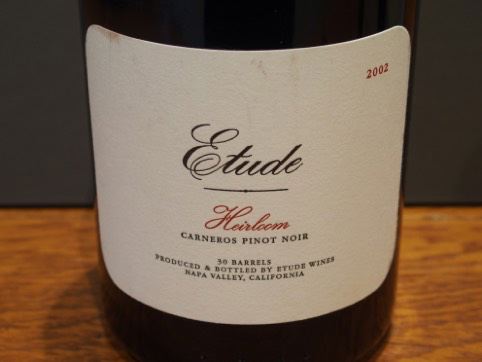 Tasting of Talisman wines is available at the winery’s quaint Tasting Room in Glen Ellen Thursday through Monday afternoons. Appointments are encouraged. Visit the website at www.talismanwine.com.
En GardeProprietor and winemaker Csaba Szakal is a polite, cerebral and focused producer of Pinot Noir and Cabernet Sauvignon, but his background is not typical. He is a former computer programmer and a fourth-generation winemaker from Hungary, a country with a rich wine history dating back to at least Roman times, but best known for Tokaji. He began making wine in his garage before his first commercial release in 2001, a gold medal winning Cabernet Sauvignon. He gathered the support of his spouse, Sandy, and launched En Garde Winery in 2007. Vineyard-designated Pinot Noirs from the Russian River Valley appeared with the 2012 vintage. I have sampled the En Garde Pinot Noirs since 2010 and observed first hand the gradual improvement in the wines. This is not surprising, for Csaba is fanatical about quality, beginning with a finicky compulsion in the vineyard and ending with dedicated attention to detail in the winery. Csaba initially received many accolades for his Napa Valley Cabernet Sauvignon, but now he says, “I take the Pinot thing more seriously.” Some of the striking 2016 vintage Pinot Noirs were previously reviewed here: www.princeofpinot.com/ article2159.com. We tasted through his five 2018 Pinot Noirs from barrel. He will be offering a Pinot Noir from Roma’s Vineyard in Anderson Valley, the Noble Family Estate Vineyard in the Petaluma Gap, a Los Carneros Sonoma Coast vineyard, and the Starkey Hill and Pleasant Hill vineyards in the Russian River Valley. Csaba ferments each clone separately so we tasted each individual clone from each vineyard. Although recently sulfured, it was easy to recognize the pedigree of the wines. The 2018 Starkey Hill Vineyard Pinot Noir was the standout. Mark this down and grab some of this 96-97 point wine when it is released. A well-known Russian River Valley producer backed out of their commitment to buy grapes from Starkey Hill so Csaba stepped in and bought more than usual so production will be generous in this vintage. Tasting is available daily at the winery’s stylish tasting room on Sonoma Highway in Kenwood. Visit the winery’s website at www.engardewinery.com to join the mailing list or purchase wines. Three additional finished wines were tasted after my trip.
2016 En Garde Sonoma Coast Pinot Noir 14.3% alc., pH 3.49, TA 0.725, 175 cases, $50. Clone 115. Harvest Brix 24.3º. Aged 17 months in French oak barrels, 20% new. · Light garnet color in the glass. Nicely perfumed with aromas of macerated black cherries. The mid weight core of juicy black cherry fruit is infused with spice and energy as well as a touch of friendly oak. This wine has a welcoming “warmth” about it. Score: 91
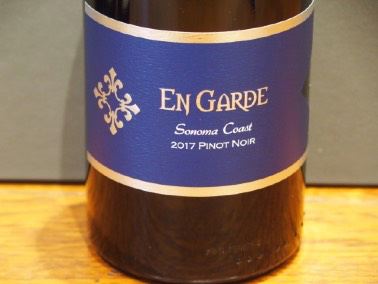 2017 En Garde Sonoma Coast Pinot Noir 13.6% alc., pH 3.45, TA 0.755, 125 cases, $50. Clones 115, 667 and 777. Harvest Brix 24.3º. Aged 18 months in French oak barrels, 20% new. · Moderately light garnet color in the glass. Pleasing aromas of dark red and blue fruits accented with oak. Silky and gracious, with a middleweight essence of black cherry. Plenty of pleasing juiciness and vibrancy with good oak integration and a driven, persistent finish. Score: 92
2017 En Garde Mendocino Ridge Vineyard Mendocino Ridge Chardonnay 14.4% alc., pH 3.57, TA 0.588, 110 cases, $45. Harvest Brix 24.6º. Aged 10 months in French oak barrels, 20% new, and stainless steel for 6 months. · Light golden yellow color in the glass. A complex nose satisfies with aromas of lemon oil, brown butter, warm croissant and waffle cone. Soft, suave and velvety in the mouth, with enticing flavors of lemon, pear, creme caramel and vanilla. Nicely composed and highly enjoyable, but I should point out that it is not an aciddriven style. Score: 92
Russian River Valley: Pisoni/Lucia, Cattleya, Benovia, Furthermore & Small Vines
Pisoni & LuciaI met Jeff Pisoni, the winemaker for Pisoni Estate, Lucia and Lucy brands, and his spouse, Bibiana González Rave the winemaker of Alma de Cattleya and Cattleya brands at their new production facility in Rohnert Park. After years of making wine in a custom crush facility in Santa Rosa, they have found a home in a business complex. Outfitted with a crush pad, a modern lab and the latest winemaking tools, the winery is befitting the iconic Pisoni name.
Most pinotphiles are well aware of the history of Pisoni Family Vineyards. Gary Pisoni, whose family has farmed vegetables in the Salinas Valley since 1952, had the notion of growing wine grapes in the Santa Lucia Highlands. Gary trusted his own instincts about what the land could provide. He encountered several objections, not the least of which was the cost. Gary countered to his father, “Have you ever been to a $250 lettuce tasting.?” His father relented and a legendary vineyard was born in 1982. Gary persisted in drilling many wells through the densely-compacted granitic soil of the family’s property and on the sixth try water did eventually gush up past the drilling rig. As a recent Pisoni newsletter proclaimed, “Possessed of the courage of their convictions and not a little quixotic spirit, sons Jeff and Mark continue to work alongside Gary toward the perfect Pinot Noir, block-by-small-named block.” Planting in 2-acre increments goes on to this day, despite the challenges. Jeff notes, “Any grape, grown well, is hard to cultivate. It takes a true romantic to plant Pinot Noir, however.” The Pisoni family offers wines under three labels: Pisoni Estate, Lucia and Lucy. Lucy is the name of a single wine, a Pinot Noir Rosé, first offered in 2003, available through a mailing list and retail and restaurant distribution. The Lucia Pinot Noir and Chardonnay appellation and vineyard-designated wines first offered in 2000, are 100% estate grown and available by mailing list, and, because of a larger production, are easily available also through distribution channels. The Pisoni Estate Pinot Noir and Chardonnay are sold almost exclusively through a mailing list. Visit the websites for information and to join the mailing lists at www.LucyWines.com, www.LuciaVineyards.com and www.PisoniVineyards.com. Refer to the Pisoni Family Vineyards blog at www.pisoninotes.com for more information and fact sheets.
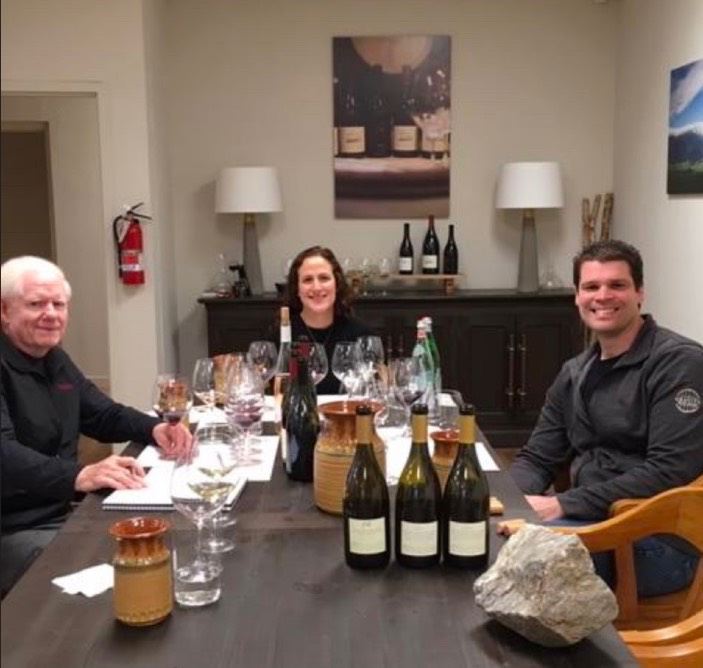 Lucy Lucy Millman was a breast cancer survivor who spotted Lucy Rosé in a local store in 2006. Contacted with this discovery, the Pisoni family immediately donated to Lucy Millman’s fund for The Susan G. Komen 3-Day®. Over a decade later, the Pisoni family continues to contribute to Lucy’s fund as well as other charities. $1 of every bottle sold is donated to breast cancer aid and research.
13.8% alc., 1,041 cases, $19. Released March 2019. Attractive packaging with a curvy bottle. 50% saignée and 50% direct whole cluster press. Held for 3 months in neutral barrels. · Pale orange color in the glass. A fruity nose highlights strawberry, with added aromas of rose petal and nuttiness. Bright, dry and quenching on the palate, with flavors of blood orange, red berry and melon. Driven by spirited acidity and finishing with some notice. Score: 89
Lucia Lucia wines are produced from the Pisoni, Garys’ and Soberanes Vineyards of the Santa Lucia Highlands (refer to map below). The wines are fermented with native yeast, vinified by gravity flow, and aged in carefully selected French oak barrels. The 2017 vintage provided welcome rain that was two-and-a-half times greater than each of the two preceding years. The warm, wet winter offered a healthy start to the grapevines and a prosperous bud break. The summer was warmer than average yet this was tempered by the Santa Lucia Highlands’ coastal winds and cooling morning fog. A record-level heat wave arrived at the beginning of September, prompting the harvesting of some blocks the first week of the month. Other blocks were irrigated to maintain and support the ripening grapes. By October 6, a month after beginning harvest, the last batch of fruit was taken. Jeff says the wines are characterized by “freshness and richness.” All the 2017 Lucia wines were released March 19, 2019, except the Garys’ Vineyard which will be released in September 2019.
2017 Lucia “SLH” Santa Lucia Highlands Pinot Noir 1,009 cases, $45. 47% Pisoni, 29% Garys’ and 24% Soberanes. 15% whole cluster. Aged 11 months in French oak barrels, 58% new. · Moderate garnet color in the glass. Profuse aromas of dark cherries and berries along with exotic spices. Beautifully balanced in a mid weight style, offering flavors of black raspberry, cola and spice with a hint of friendly oak. Texturally interesting, with modest tannins and some finishing persistence. Plenty of umami in this excellent appellation wine. Score: 91
2017 Lucia Soberanes Vineyard Santa Lucia Highlands Pinot Noir 307 cases, $65. Tightly spaced vines over 33 acres of Pinot Noir, Chardonnay and Syrah. California and Burgundy heritage selections. 20% whole cluster. Aged 11 months in French oak barrels, 43% new. · Moderately dark garnet color in the glass. Aromas of dark berries and fertile earth lead to a middleweight-styled wine with a punch of earth-toned black cherry fruit infused with iron minerality. Well-mannered tannin structure and some finishing length. Score: 93
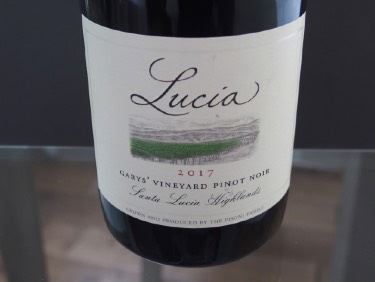 2017 Lucia Garys’ Vineyard Santa Lucia Highlands Pinot Noir 14.3% alc., 750 cases, $65. · Dark garnet color in the glass. Soaring aromas of black cherry, spice and cinnamon toast. The core of chewy dark red and black cherry is delicious and really makes an impression off the bat. Bright acidity provides good energy, the tannins are mellow, the compliment of oak satisfies, and the finish is noticeably intense and lasting. Score: 94
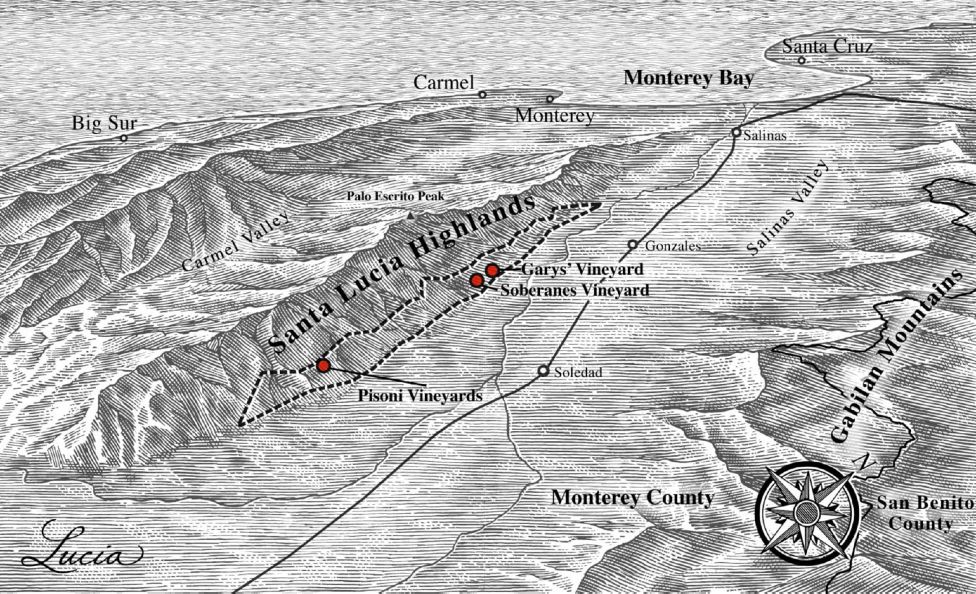 The Lucia Chardonnays are 100% estate grown. They are vinified with native yeast and undergo 100% malolactic fermentation. After aging in French oak, the wines are sent to stainless steel to achieve a delicate reduction. Seven clones, mostly Wente, are the basis of the wines.
2017 Lucia “SLH” Santa Lucia Highlands Chardonnay 14.1% alc., 512 cases, $45. Aged 11 months in French oak barrels, 24% new. · Light golden yellow color in the glass. Aromas of citrus fruits, white stone fruits and nutty oak. Bright and awash in well-ripened white stone fruit and pineapple flavors with a chalky tone on the satisfying uplifting finish. Score: 91
2017 Lucia Soberanes Vineyard Santa Lucia Highlands Chardonnay 14.1% alc., 199 cases, $65. Vineyard is granite-laden. Aged 15 months in French oak barrels, 50% new. · Mild golden yellow color in the glass. Aromas of lemon oil and petrichor lead to an acid-driven, bracing wine sporting crisp flavors of lemon-lime. Edgy and energetic, and a stellar food-friendly wine. Score: 93
Pisoni Estate The Pisoni Estate Pinot Noir and Chardonnay will be released in September 2019. Each year the Pisoni family produces just one Pinot Noir and Chardonnay under the Pisoni Estate name. Production of the Pinot Noir is limited annually to between 500 and 800 cases, depending on yields. The Pinot Noir is fermented in large oak foudres, spends the first year aging in barrel, and the second in bottle until ready for release. The wines are carefully wrapped in logo-embossed tissue and packaged in wood boxes. Something I learned from Jeff is important to repeat. Although some California wineries.vineyards claim to have the “Pisoni clone,” the Pisoni family has never allowed any outsider other than through a partnership with Gary Franscioni to take cuttings from their Estate Vineyard. There have been instances where winegrowers have attempt to steal vine cuttings. Cuttings have been propagated at Pisoni Vineyard (100% Pisoni clone), Garys’ Vineyard (100% Pisoni clone), Rosella’s Vineyard (Dijon and Pisoni clones), Soberanes Vineyard (Dijon and Pisoni clones), and Sierra Mar Vineyard (Dijon and Pisoni clones). I have such admiration for the Pisoni Estate Pinot Noir that I have purchased it annually for years. It is an iconic wine, unlike any other California Pinot Noir.
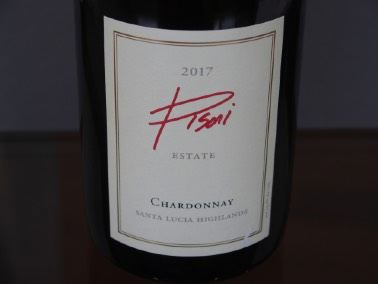 2017 Pisoni Estate Santa Lucia Highlands Chardonnay 14.1% alc., 85 cases, $80. The Chardonnay vines at Pisoni Estate are perched at 1300 feet elevation where the soils have more granite, schist and gravel and no clay. · Moderate golden yellow color with a very slight haze (unfiltered) in the glass. Engaging aromas of lemon oil, yellow apple, white peach, honey and nutty oak. Soft and sleek in the mouth, with flavors that echo the aromas. Oak finds a pleasing niche. Nicely integrated natural acidity, with a slight salinity, and a pleasing, chalky finish. A striking, texture-driven Chardonnay superb by any measure. Score: 96
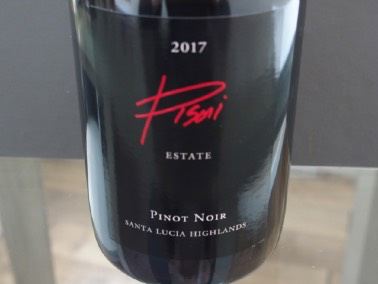 2017 Pisoni Estate Santa Lucia Highlands Pinot Noir 14.1% alc., 725 cases, $90. · Moderately dark garnet color in the glass. Lovely aromas of dark raspberry, blackest cherry, rose petal and toast. Very charming array of dark red and black fruits with an inviting touch of spice. Firm but not foreboding tannins support the fruit load nicely, producing only a trace of astringency on the finish. Silken in texture and rather elegant in this vintage yet fat enough in the mouth to satisfy fruit hedonists. Some of the black cherry fragrance returns to haunt the long, long finish. Needs more time in the cellar to fully assimilate the tannins, find full fruit expression, and reach an orgasmic level. Score: 95
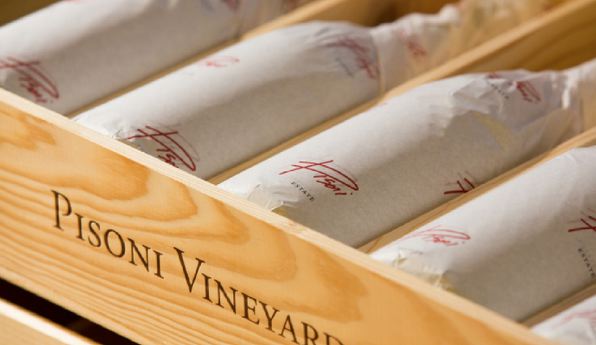
CattleyaBibiana González Ruiz is the proprietor and winemaker for Cattleya (“kat-ley-uh”). A native of Columbia, where vineyards are virtually non-existent, she has had a personal winemaking journey across several continents and languages, and today is considered one of California’s most accomplished young winemakers. She has worked in Côte-Rotie, Alsace, Burgundy and Bordeaux and in California at La Crema, Peay Vineyards, Au Bon Climat, Qupé and Lynmar Estate. In 2012, she started her own label, Cattleya, and became the winemaker for Wayfarer and later Pahlmeyer. One wine critic, Antonio Galloni, tabbed her as “One of the most talented young winemakers in the United States.” Cattleya is an orchid and the national flower of Columbia. Bibiana says, “The symbol of the Cattleya flower reflects the uniqueness of a small and delicate flower that flourishes deep in the Colombian rainforests - dependent on its unique terroir to produce its exquisite shapes and colors. In addition, this icon continues to remind me every day of the roots where I come from and the values of integrity and honesty that I learned living in a country - at the time submerged in violence and drug trafficking.” 2019 represents a year of new wines and updates for Cattleya. A new label design, a new website, and an emphasis on the cattleya orchid brand icon across all labels. The appellation wines will continue the precedent she set in Cuvée Number One, while the single vineyard or single block cuvée names are being changed in order to mark a transition for Cattleya from vineyard names to symbolic names that represent Bibiana’s journey. The 2017 Russian River Valley Pinot Noir, Cuvée Number One, is so named because it represents Bibiana’s first appellation blend under Cattleya Wines. The 2017 Sonoma Coast Chardonnay is called Cuvée Number Five, representing her fifth vineyard source for Cattleya Wines. Learn more and sign up for the mailing list at www.cattleyawines.com. The Alma de Cattleya and Cattleya wines were released in March 2019 and the Cattleya Belly of the Whale Carneros Pinot Noir will be released in September 2019.
Alma de Cattleya These wines are 100% varietal (not blends) and sourced only from Sonoma County.They represent excellent value and are the perfect accompaniment to everyday meals and relaxing moments. The website for these wines is www.AdCWines.com.
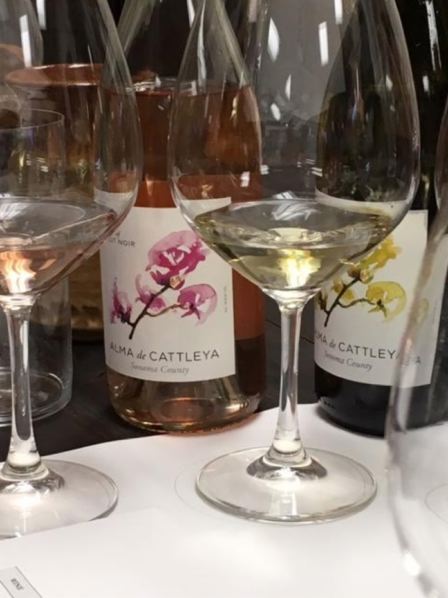
2018 Alma de Cattleya Sonoma County Rosé of Pinot Noir 14.1% alc., pH 3.32, TA 0.57, 500 cases, $20, DIAM cork closure. Pommard and dijon 115. Made by whole cluster pressing with the intention of specifically making rosé. Inoculated with a selection of French yeasts, no malolactic fermentation, aged 6 months in the cellar. · Light pink color in the glass. The nose offers a combination of rose petal, cherry and botanical aromas. Infused with flavors of strawberry, cherry and herbs and driven by a modicum of acidity. Score: 88
2017 Alma de Cattleya Sonoma County Chardonnay 14.1% alc., pH 3.32, TA 0.62, 600 cases $24, DIAM cork closure. Clones are a combination of Old Wente, 78, 15 and 4 from ten different vineyard blocks. After pressing, the juice is settled overnight and then transferred to stainless steel tanks and barrels (15% of the volume ferments) for alcoholic fermentation. The juice is inoculated with French yeast and undergoes partial malolactic fermentation. Aged 15 months before bottling. · Light golden yellow color in the glass. Pleasant aromas of lemon, baking spices and a hint of oak. Suave in the mouth with bright acidity, offering flavors of lemon, pineapple and melon. Nicely balanced and easy to like. A special value. Score: 90
2017 Alma de Cattleya Sonoma County Pinot Noir 14.1% alc., pH 3.64, TA 0.59, 1,600 cases, $28, DIAM closure. A blend of four vineyards and eight clones including Dijon Pommard and Calera. 100% de-stemmed fruit, short cold soak, fermented with a combination of native and proprietary yeasts. Aged 16 months in French oak barrels, 15% new. · Moderately light garnet color in the glass. The nose is highlighted with aromas of cherry, savory herbs and underbrush. A savory, light to mid weight styled wine with flavors of cherry and herbs. Easygoing, with modest tannins. Score: 88
Cattleya
2017 Cattleya Cuvée Number Five Sonoma Coast Chardonnay 14.5% alc., 167 cases, $50. A blend of Old Wente, clone 78 and clone 15 from two vineyard sites. Gently whole cluster pressed with a small bladder press. The free-run juice was settled overnight in stainless steel tanks before being transferred to French oak barrels and puncheons for fermentation. 100% malolactic fermentation. Aged 11 months in neutral French oak barrels. · Moderately light golden yellow color in the glass. Well-ripened yellow peach, apple and pineapple aromas and flavors are featured. Quite charming, with enviable balance, a suave texture and energetic acidity. The wine literally slides off the back of the palate. Score: 92
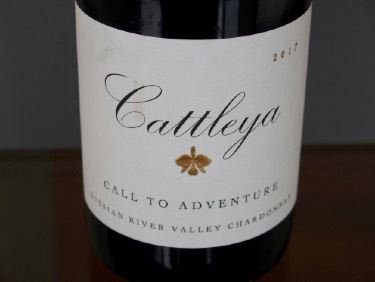 2017 Cattleya Call to Adventure Russian River Valley Chardonnay 14.3% alc., 68 cases, $70. The name is derived from Bibiana’s start of her own winery marking a new adventure. Sourced from Pratt Vineyard. Four rows of Clone 15 were planted about 20 years ago by Jim Pratt. Whole cluster pressed and cold-settled overnight. Primary fermentation lasted four months followed by complete malolactic fermentation. Aged 16 months in 100% new French oak barrels. Bottled unfined and unfiltered. · Moderately light golden yellow color in the glass. This is a wine to please those looking for both fruit and minerality. There is a delightful array of stone fruit, lemon and pineapple fruit aromas and flavors along with oak-driven notes of spice, brioche, honey and toffee. This wine always delivers a delicious drinking experience and has the right cut and lip-smacking length to satisfy. Even better when tasted a day after opening. Score: 94
2017 Cattleya Cuvée Number One Russian River Valley Pinot Noir 14.5% alc., 135 cases, $50. Grapes were sourced from the cool Green Valley. Pommard (includes whole cluster) and 115 in about equal proportions. Each clone was fermented separately in a stainless steel open-top tank. 100% de-stemmed, 10- day cold soak. Aged in French oak barrels, 50% new. Bottled in August 2018 unfined and unfiltered. · Moderately dark garnet color in the glass. Aromas of purple grape, savory herbs and tobacco. Well-spiced flavors of black cherry and black raspberry taking on more appeal over time in the glass. The wine has wellintegrated, fine-grain tannins and a glamorous finish offering both savory and fruity pleasures. Score: 93
2017 Cattleya Belly of the Whale Carneros Pinot Noir 14.2% alc., 78 cases, $70. Sourced from the 45- acre Donum Estate Vineyard. Roederer clone from the oldest block. 100% de-stemmed, 10-day cold soak, fermented on the skins for 24 days, and aged 16 months in French oak barrels, 50% new. Bottled unfined and unfiltered. · Moderate garnet color in the glass. Clean and spirited aromas of fresh black cherry, pomegranate, rose petal, sous bois, smores and cigar. Robust, virile and fruit-driven, featuring deep, dark flavors of black cherry and blackberry that flood the palate with goodness. Full-flavored, yet has welcome finesse and a silken mouthfeel. The felty tannins fit right in, the vibrant acidity elevates, and a sneaky hint of savoriness peaks one’s interest. Score: 93
Benovia WineryI have reviewed Benovia Pinot Noir wines from every vintage since their first commercial release in 2006. I like to describe the wines as big teddy bears that are easy to cozy up to. They are bold expressions of Pinot Noir, yet are infused with gracious tannins and redeeming acidity making them easily accessible upon release. The wines are vinified in a winery dedicated to Pinot Noir by veteran Sonoma County winemaker Michael Sullivan. He prefers de-stemming grapes, although some bottlings in select vintages may have up to 30% whole cluster inclusion. Indigenous yeast fermentations follow a cold soak and aging occurs in French oak barrels for 16 months in a moderate amount of new oak (about 30%-40%). Most of the current vintage wines are produced from Estate grown grapes (Martaella, Tilton Hill, and Cohn vineyards). Grower vineyards include Three Sisters in the Fort Ross-Seaview AVA and Zio Tony Ranch (labeled La Pommeraie) in the Green Valley of the Russian River Valley, both Martinelli owned and farmed vineyards. The Bella Una Pinot Noir is a winemaker’s selection of barrels that best express the vintage. Except for the Russian River Valley Pinot Noir and the Three Sisters Chardonnay, the 2017 vintage wines reviewed here are pre-release so I do not have detailed production information. Prices usually run from $42 for the Russian River Valley Pinot Noir to $60-$75 for the vineyard-designated Pinot Noirs and topping out at $80 for the Bella Una bottling. The Chardonnays start at $38 for the Russian River Valley bottling to $52 for the vineyard designates. The Benovia Winery hospitality center is adjacent to the winery and surrounded by the vines of Martaella Vineyard. A very personable hospitality team is available to receive wine enthusiasts by appointment. Visit the website at www.benoviawinery.com. Benovia has released its first sparkling wine, a 2015 Russian River Valley Blanc De Noir, a 50/50 blend of Pinot Noir and Chardonnay made in the traditional méthode champenoise. A 2017 “Liberation” Pinot Noir is a one-time offering with a percentage of sales being donated to a D-Day Squadron charitable fund that is helping to transport veterans, students and WWII-era aircraft to the 75th celebration in Normandy including the “Spirit of Benovia” C-54 this year.
 The 2017 vintage wines from Benovia are a darkly colored, ripe, fruit-driven style with modest tannins and well-managed oak. If there is one criticism to be leveled, and this is always difficult given the consistent excellence of Mike Sullivan’s Pinot Noirs, it is that all the Russian River bottlings taste very similar in this vintage but that may be a reflection of their immaturity.
2017 Benovia Russian River Valley Pinot Noir 14.1% alc., pH 3.62, TA 0.60, $45. Aged 16 months in French oak barrels, 37% new. · Moderately dark garnet color in the glass. Aromas of blackest cherry, black grape juice, spice and a hint of vanillin. The wine is fruit-propelled with layers of gregarious black cherry and blackberry fruits. Restrained tannins, with a sweet-fruited, lip-smacking finish of some length. Score: 90
2017 Benovia Cohn Vineyard Sonoma County Pinot Noir 14.1% alc.. · Moderately dark garnet color in the glass. The wine opens slowly to reveal aromas of black raspberry, black cherry, vanillin and herbal underbrush. Middleweight in style, with flavors of boysenberry and black cherry with a savory herbaceous thread. Modest tannins and finish. Fine, but doesn’t excite. Unchanged when tasted the following day from a previously opened and re-corked bottle. Score: 89
2017 Benovia Three Sisters Vineyard Fort Ross-Seaview Pinot Noir 14.2% alc.. · Moderately light garnet color in the glass. The nose is both fruity and savory, offering aromas of dark red cherry and dried herbs. Lighter in style, featuring flavors of cherry, raspberry and baking spice. The outlier in the 2017 lineup with the least extract and most elegance. Soft, fine-grain tannins and a modest finish. This wine reflects its cooler climate origin. Score: 91
2017 Benovia Martaella Vineyard Russian River Valley Pinot Noir 14.5% alc.. · Dark garnet color in the glass. A step up in extraction with an expansive flood of regal purple and blackberry fruits on the nose and palate. Really luscious, yet juicy and polished, with a big, sweet-fruited finish tempered with gracious tannins. Score: 93
2017 Benovia La Pommeraie Russian River Valley Pinot Noir 14.5% alc.. · Dark garnet color in the glass. Shy aromas of black fruits, fruitcake, wine cave and vanillin. Full-bodied, well-ripened and fruit-driven, very similar to the Martaella Vineyard bottling. A hunky Pinot Noir with reigned-in tannins, welcome acidity, a suave texture and a lip-smacking finish. Impressive balance. Score: 93
2017 Benovia Tilton Hill Vineyard Sonoma Coast Pinot Noir 14.2% alc.. · Dark garnet color in the glass. Terrific nose with soaring aromas of spice, dark raspberry, fertile earth, burnt tobacco and vanillin. A mid weight load of sweet boysenberry and black raspberry fruits is buffered by gracious oak. I suspect more whole cluster in this wine because of more tannin that donates some astringency on the length finish. When tasted the following day from a previously opened and re-corked bottle, the superb aromatics persisted as did the mildly astringent tannins. Score: 91
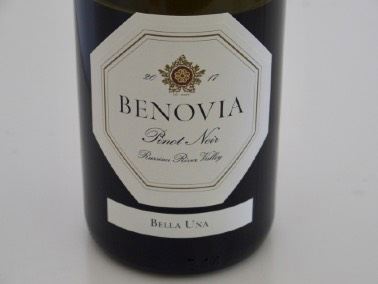 2017 Benovia Bella Una Russian River Valley Pinot Noir 14.2 % alc.. · Dark garnet color in the glass. This winemaker’s selection brings together all the best features of the vineyard designates. The concentration is more tempered and the wine is more sophisticated. Aromas of purple berry, warm baking spice and biscuit lead to a mid weight plus style wine offering a discreet arsenal of purple and black fruit flavors. Very suave and sleek, with impeccable harmony, a shadow of oak, and a very long finish replete with an abundance of boysenberry goodness. Score: 94
2017 Benovia Three Sisters Vineyard Fort Ross-Seaview Chardonnay 14.1% alc., pH 3.64, TA 0.56. Aged 16 months in French oak barrels, 30% new. · Moderate golden yellow with the slightest haze in the glass. Hitone aromas of yellow apple, white flower blossom, buttered popcorn, honey and butterscotch. Richly flavored in a lower-acid style, with flavors of lemon, pineapple and yellow peach. A chalky, salty thread plies the background. Finishes with good fruit persistence. Score: 92
2017 Benovia La Pommeraie Russian River Valley Chardonnay 14.5% alc.. · Moderate golden yellow color in the glass. A hint of reduction, lemon oil and buttery brioche on the nose. Refined and more steely and acid-driven with bright lemon notes that last through the lengthy finish. Subtle flavors of vanilla, green apple and butterscotch add interest. Very clean and bracing with a refreshing demeanor. An outstanding Chardonnay primed for shellfish. Score: 94
FurthermoreCo-proprietor Chad Richard was on site in Sebastopol when I visited on a recent Mother’s Day. Dressed in a tee shirt and jeans, one would never know that he is a tech mogul who has launched several tech companies and worked for Apple and Yelp. Still working in the tech world, he has a house in Occidental and is at the winery (the former Graton Ridge Cellars acquired in 2015) frequently, welcoming guests to his laid back tasting room and grounds. People have remarked that being at Furthermore is like sipping wine in a best friend’s backyard. Furthermore specializes in Pinot Noir made with grapes made from two estate vineyards (Graton Ridge Vineyard) where the winery and tasting room are located) and Nevina’s in Occidental, as well as sourced from all over California, including the Russian River Valley, Sonoma Coast, Santa Lucia Highlands and Sta. Rita Hills. The wines have shown consistency if not brilliance at times and have won many gold medal awards at the San Francisco Chronicle Wine Competition since the first release in 2006. The winemaker is Erica Stancliff. I recently tasted several releases here: www.princeofpinot.com/article/2170/. The Furthermore wines are available online, at the tasting room and through a mailing list. The tasting room is open daily. Two guest houses are available for rent, one on the Furthermore Winery property and one in Occidental.
2016 Furthermore Russian River Valley Pinot Noir 14.5% alc., pH 3.71, 416 cases, $40. Release June 15, 2019. Aged 10 months in French oak barrels, 20% new. · Moderate garnet color in the glass. Ripe Bing cherry aroma framed by toasty oak. Sleek in the mouth and silken in texture with a mid weight core of black cherry fruit overlain with oak. The mouthfeel is the best feature of this wine that has Russian River Valley typicality, but the fruit is a tad too ripe and too embellished with oak. Score: 88
2015 Furthermore Sierra Mar Vineyard Santa Lucia Highlands Pinot Noir 13.9% alc., 101 cases, $50. Pommard and Pisoni clones. Harvest Brix 26.1º. · Moderately light garnet color in the glass. A light to mid weighted style that has seductive elegance. Aromas and flavors of red cherry and red berry with a hint of spice and a good grip of acidity on the bountiful finish. The barrel management is spot on. Score: 91
2015 Furthermore Rosella’s Vineyard Santa Lucia Highlands Pinot Noir 14.6% alc., 101 cases, $55. Pisoni and “828” clones. Harvest Brix 26.8º. · Moderate garnet color in the glass. Aromas of black grape, dark rose petal and molasses. The chewy fruit veers to the roasted side. Nicely composed, with gentile tannins and gracious acidity, progressing to a modest finish. More darkly fruited than is typical for Rosella’s Vineyard and not an identifiable reflection of this vineyard because of the ultra ripeness. Score: 89
Small VinesWe visited Paul and Katherine Sloan at Small Vines in Sebastopol in early December of 2018 - www.princeofpinot.com/article/2126/ - but we had such an enjoyable time, we took Katherine up on an invitation to re-visit on this trip. Since selfies are so popular now, I decided to include one of myself and my spouse Patti at Small Vines.
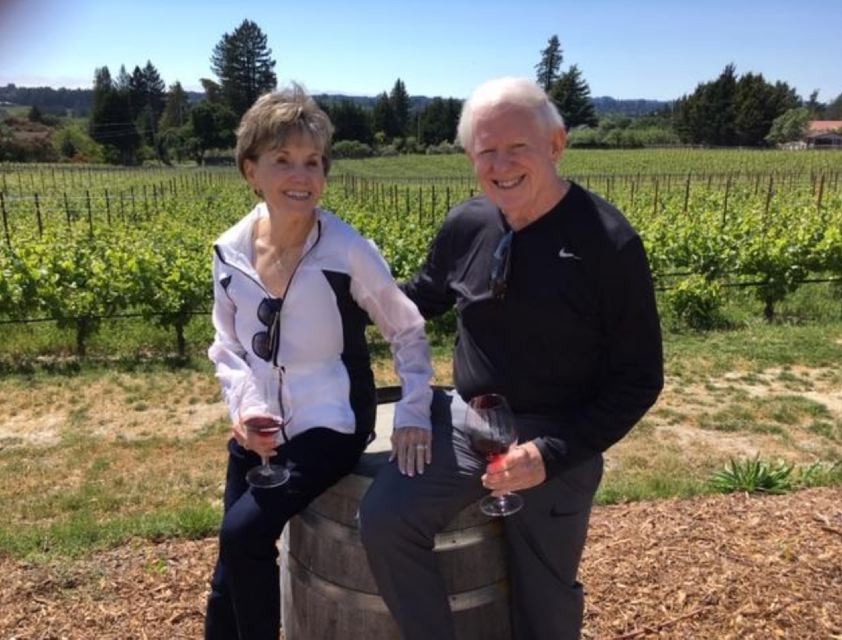 The Small Vines winery is an uncrowded (appointment only) and modern facility in a beautiful, pastoral setting, unlike many larger custom crush facilities. It is a winemaker’s winery. For ten years, Small Vines and consulting winemaker Byron Kosuge have been working together and are now offering custom crush facilities at the Small Vines winemaking facility inside an historic building. In the early 1920s, Leland Barlow built a state-of-the-art for its time apple cold storage building on the historic Barlow Family Homestead in Sebastopol. This poured concrete structure was transformed into a small-lot winemaking facility and opened just prior to the 2017 harvest. The Small Vines tasting room is adjacent to the winery overlooking the estate vineyard. Byron Kosuge and Paul Sloan collaborate on the Small Vines Pinot Noir and Chardonnay wines. Paul is a noted viticulturist in Sonoma County but also has become immersed in winemaking. Byron, a UC Davis graduate, has been making wine for over 30 years. In addition to Small Vines, he works with several artisan brands including Miura, McIntyre Vineyards, Alder Springs Vineyard and McEvoy Ranch. On the most recent visit, Katherine offered a vertical tasting of wines from the TBH Vineyard that surrounds the Sloan’s home and winery. A Pinot Noir and Chardonnay from the TBH Vineyard were first offered in the 2014 vintage. The vineyard was planted in 2009 by the Sloans Small Vines Viticulture company. Its location in the Sonoma Coast AVA exposes it to heavy coastal influences. Vines are planted in a high-density fashion (2722-3630 vines per acre) in Goldridge sandy loam soil. In the background of the photo above, you can see the high-density, small vine plantings at the TBH Vineyard. In the photo below is an example of the typical small clusters from this vineyard.
 For Chardonnay, Hyde Wente and Kistler Mt. Eden Wente selections are planted. The wines are whole cluster pressed and barrel fermented with native yeast and native ML with minimal batonnage. Aging is carried out in French oak barrels with a small percentage of new oak. The wines are bottled unfined and unfiltered. These wines are ideal for those seeking out Chardonnay that is not heavily embellished with oak accruements and more acid-driven. The 2016 vintage was $72. The TBH Pinot Noir is based on Calera, Swan, Pommard, and Dijon 943 and 459 clones. Yields are typically low at about 1 lb per vine. A significant amount of whole cluster is used, the wines are native yeast fermented, and aged 15 months on fine lees in French oak barrels, about 25% new. Only free-run juice is used. These wines are relatively low in alcohol and will appeal to those seeking juiciness and energy in Pinot Noir. The wines are bottled unfined and unfiltered. The 2016 vintage was $82. All TBH wines are a fastidious shoot by shoot selection. Small Vines wines are sold primarily through a mailing list. A tasting, conducted by Paul or Katherine, is available by appointment. Visit www.smallvines.com.
2014 Small Vines TBH Vineyard Sonoma Coast Pinot Noir 13.2% alc., 309 cases. · Lovely aromas of deep cherry, raspberry and pepper. Love the nose. Terrific core of black cherry and blueberry fruits that are framed by compatible tannins. The wine has an elegant demeanor with fully immersed oak. Probably in its prime drinking window now but will last many more years. Score: 95
2015 Small Vines TBH Vineyard Sonoma Coast Pinot Noir 13.2% alc., 246 cases. · The nose offers more botanical than fruit aromas. Silky and elegantly composed, featuring a mid weight array of red fruits backed by gracious tannins and underlain with a savory herbaceous component. Score: 92
2016 Small Vines TBH Vineyard Sonoma Coast Pinot Noir 13.2% alc., 295 cases. · Penetrating aromas of black cherry and purple berry that won’t stop. Plenty of satisfying purple and black fruits with some, but not imposing tannins. The structure should serve this wine well in the long term. The 2016 vintage is spectacular. Score: 94
2017 Small Vines TBH Vineyard Sonoma Coast Pinot Noir 13.2% alc., 295 cases. · Deep garnet color. Very aromatic with scents of black cherry and peppery spice that draw you into the glass. A charge of well-ripened dark red and purple fruits saturate the palate. Showing fruit adolescent exuberance, and the young tannins need more time to assimilate. There is more fruit extraction and more tannin in this wine but the balance is spot on. Excellent potential. Score: 94
2014 Small Vines TBH Vineyard Sonoma Coast Chardonnay 13.7% alc., 347 cases. · This wine is showing an aged profile with aromas of lemon and apple fruits and a hint of sherry. Excellent vigor with steely, refreshing acidity and a flavor profile centered on lemon wafer and green apple. Score: 92
2015 Small Vines TBH Vineyard Sonoma Coast Chardonnay 13.7% alc., 221 cases. · Fresh aromas of lemon oil and friendly oak. More fullness in the mouth with more extraction and a riper profile including flavors of pineapple and tropical fruits. Well-integrated acidity. I really like the discrete richness. Score: 93
2016 Small Vines TBH Vineyard Sonoma Coast Chardonnay 13.6% alc., 295 cases. · Yellow citrus and green apple drive the aroma and flavor profile in this very juicy wine. Very gracious, with impeccable harmony and a noticeably long finish that is bursting with aromatic goodness. My favorite. Score: 94
2017 Small Vines TBH Vineyard Sonoma Coast Chardonnay 13.8% alc., 400 cases. · The freshest wine in the lineup with bright citrus peel, apricot and apple aromas. Still young and rather simple, but enjoyable for its integrated acidity and crisp flavors of lemon and green apple. Score: 93
 |